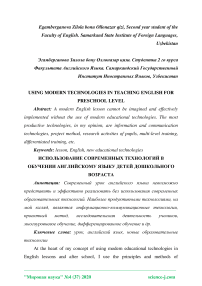Using modern technologies in teaching English for preschool level
Автор: Egamberganova Z.O.
Журнал: Мировая наука @science-j
Рубрика: Гуманитарные и общественные науки
Статья в выпуске: 4 (37), 2020 года.
Бесплатный доступ
A modern English lesson cannot be imagined and effectively implemented without the use of modern educational technologies. The most productive technologies, in my opinion, are information and communication technologies, project method, research activities of pupils, multi-level training, differentiated training, etc.
Lesson, english, new educational technologies
Короткий адрес: https://sciup.org/140265545
IDR: 140265545 | УДК: 004.02:004.5:004.9
Текст научной статьи Using modern technologies in teaching English for preschool level
At the heart of my concept of using modern educational technologies in English lessons and after school, I use the principles and methods of competence-based education, technologies of personal-oriented and developmental learning, and actively use strategies and techniques for teaching semantic reading and working with text. Taking into account the fact that classes often have pupils with different levels of language training in each of their lessons, I use several modern educational technologies:
-
• information-communication,
-
• project method,
* pupils ' research activities,
-
* multi-level training,
-
* differentiated training,
-
• collaborative learning technology or group work,
-
* health-saving technologies.
Due to the fact that each class immediately highlights differences in the level of learning among pupils, the most acceptable and relevant in the organization of the educational process is the technology of intra-class differentiation with the addition of elements of multi-level learning. Taking into account the typological features of each pupil, I divide the class into conditional groups "A", "B", "C". I use techniques of teamwork, for dynamic pairs or groups. Tasks of group "C" are fixed as the basic standard — minimal or reproductive. Here I highlight the multiplicity of repetition, teach you to allocate lexical supports. Tasks " B " are built on an analytical and synthetic level and provide the mental activity that is necessary to solve tasks for use. Job group "A" assume the creative or production level. Pupils consciously and creatively apply their knowledge by making mini-dialogues and monologues on the topic. Elements of the organization of the group form of work allow me to activate the cognitive activity of pupils in the classroom, to include each pupil in the learning process. Within the groups, everyone can Express their opinion, actively participate in the decision of educational programs, in accordance with the level of language training, studied lexical units. For each lesson, I create didactic material of different complexity. All this gives a tangible educational result.
The use of information and communication technologies.
I consider information and communication technologies to be one of the leading technologies in organizing the educational process in the classroom and outside of school hours. The use of ICT at various stages of the lesson allows me to optimize the educational process, effectively use time. When explaining the new material for clarity, I use computer presentations in Microsoft Power Point (including those created by the pupils themselves, after a preliminary check by the teacher), videos from the site , educational films, video clips, excerpts from animated and feature films, electronic applications.
Using the technology of project training and research activities.
I consider the method of projects one of the leading ones in the formation of pupils' speech competence, the ability to use a foreign language as a tool for intercultural communication and interaction. Therefore, one of the main tasks is to develop pupils ' skills in project activities.
Games.
Games allow you to implement a differentiated approach to pupils, involve each pupil in the work, considering their interests, aptitude, level of training in the language. Exercises of a game character enrich pupils with new impressions, activate the vocabulary, perform a developing function, and relieve fatigue.
The "Mind-Map" method is a simple technology for recording thoughts, ideas, and conversations. Recording is fast and associative. The theme is in the center. First there is a word, an idea, a thought. There is a flow of ideas, their number is unlimited, they are all fixed, we start writing them down from the top left and finish on the bottom right.
Список литературы Using modern technologies in teaching English for preschool level
- Ruzieva Nafisa Zarifovna The importance of using games in teaching English as a second language // Достижения науки и образования. 2017. №5 (18).
- Sayitova Komila Hasanovna Advantages of using brainstormers at English classes // Проблемы педагогики. 2018. №2 (34).


